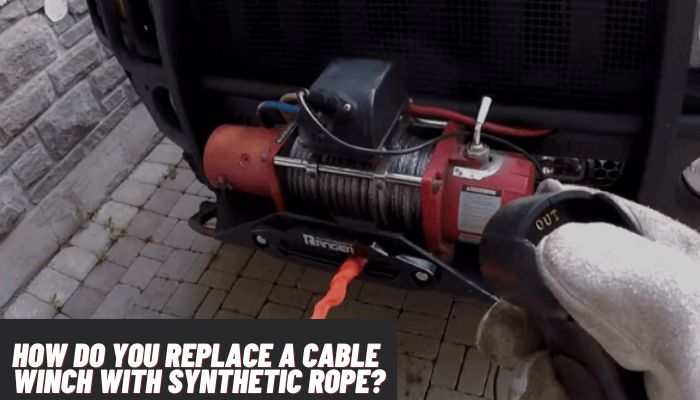It’s relatively easier when you’re buying a brand-new winch as you can choose one with cable or rope pre-installed.
But when you’re planning on replacing the current cable winch, you will end up wondering whether can you put synthetic rope on a cable winch or not.
Turns out, you can replace your steel cable with a synthetic rope just fine! But you must make sure the drum surface is smooth and doesn’t have any burrs. Sharp burrs will ruin the rope.
We’re talking about both steel cables and wire ropes today, along with what they offer and how they do in action.
If you’re planning to replace your cable with synthetic rope, let’s help you do it right with precautions and best practices:
Why Synthetic Winch Rope Is Better Than Cable?
Making the right decision while selecting the winch cable option is not easy. Both steel and synthetic ropes have their highs and lows to be traded with.

First off, a steel cable will put extra weight on your vehicle. That’s no good, especially for ATVs. For such small vehicles, you must get a winch with synthetic rope for ATV with much less weight.
In terms of safety, you get no burrs on synthetic like you do on steel cables. On the other hand, while steel cable can be fatal if snapped, synthetic is a million times safer if snapped.
If we take longevity into account, a synthetic rope can last longer with proper cautions like protection sleeve and smooth fairlead.
In short, the extreme flexibility and less weight make synthetic rope more convenient to handle than steel. Plus, synthetic rope’s biggest advantage is that it doesn’t kink like steel cable.
Is It Possible To Put Synthetic Rope On A Cable Winch?
Okay, this is somewhat tricky to say whether can you put a synthetic rope on a cable winch or not. That’s because technically, it’s absolutely okay to put a synthetic rope on a cable winch.

However, the tricky part is, since worn-out cables with burrs all over can leave streaks on the winch drum and the fairlead. These sharp surfaces can damage the synthetic cable.
So, you’ll have to make sure there are no sharp edges or surfaces to compromise the integrity of the rope.
With that said, if you install a synthetic rope on your winch instead of steel cable, there are tons of benefits. Some of them would be:
Installing Is Straightforward
The first advantage of using a synthetic rope instead of a steel rope will be the ease of installation. While installing a steel cable can take a toll on your muscles, doing it with a synthetic rope will be a piece of cake.
Maneuvering Is Easy
Synthetic ropes are easy to install because they’re easy to maneuver and bend. As you already know that bending or handling a steel cable is like getting into a war, and synthetic can come in as a savior.
Repair And Customization Process Is Pretty Simple
Not only the synthetic rope is easy to maneuver, but it’s also easy to repair in case of a snap while winching. You can bend it single-handedly, cut it with a pair of scissors, and make a loop with almost no tools.
Less Weight To Carry
Probably the most important reason why people go for synthetic in the first place, is the weight. You should put as less weight as possible on the bumper to avoid sagging, especially for lightweight cars.
And synthetic ropes offer you just that. While a 50-feet steel rope can weigh over 60 lbs, a 50-feet synthetic rope will weigh only 1 pound.
Easy And Effortless To Operate
Using a synthetic rope is much easier than a steel cable. You can take out the winch line quickly and wrap it around a tree or maneuver around a tire or so. With a steel cable, the ease of operation remains a dream.
Protected From Snaps And Kinks
Let’s face it, when you’re using a steel cable and pulling to its maximum strength or beyond, you know you’re at risk. The cable could snap anytime which can be life-threatening. With a synthetic rope, that risk factor lays at close to zero.
Greater Safety For Family
If you have kids or pets that roam around while you’re working with the winch, it’s better you go synthetic. While steel cable can pose a threat to the safety of your family members, a synthetic rope is a much safer option.
What Is The Easiest Process To Replace A Cable Winch With Synthetic Rope?
Replacing the steel cable on a winch with a synthetic rope is an easy process if you follow the right steps.
First, you need to take the steel cable off the winch before you can replace it with a synthetic rope. You need to spool out the whole wire, undo the bolting or the tie that keeps the wire in place.

After that, you should give it a thorough inspection to understand if there is anything sharp remained on the spindle. Be sure to flatten them if you find any, and smoothen the drum.
For the fairlead, it’s better to have an aluminum one for synthetic rope with smooth round outer face.
Once you have the steel rope out, there are a few methods of installing the synthetic rope on the drum. Here’s the easiest one:
- Find a rope lock: First, you’ll need a winch rope lock that will help you install the rope on the drum.
- Place the lock in: Place the lock on the left side of the drum, facing downwards so that you can feed through it.
- Feed the rope: Feed the rope through the aluminum fairlead, then through the rope lock’s right eyelet.
- Give it some rolls: Now roll the rope on the drum with 5-6 rotation, keeping it nicely snug to the bottom.
- Lock it up well: Once you reach the end of the rope lock, feed the rope through the other eyelet and pull the main rope.
That is how you install a synthetic rope and replace your steel cable. Here’s a video to help you understand the process better.
We’ve talked a few more methods in our previous guide on how to tie synthetic winch rope.
What Can You Do To Protect Your Synthetic Winch Rope?
Installing a synthetic rope on a winch is not complete if you can’t get the full out of it. Synthetic ropes have a few drawbacks, like being prone to abrasion and UV rays. So you need to take precautions to prevent weakening. They are:
- Protective sleeve: Put a protective sleeve on both ends of the rope while installing it. That will keep the rope in good shape when coming in contact of rocks or sharp tings.
- Damaged strands: Don’t damage the strands of the synthetic rope while making the eye hook if you ever do so. You can practice making the eyelet on a scrap piece of rope before doing for real.
- Keep cool: Excessive heat is not a good thing for synthetic rope. It can weaken when the heat reaches over 150° from the outer strands. So, give it resting time before working over and again.
- Smooth fairlead: Make sure that you’re installing the rope with a smooth aluminum fairlead. Using a 4-way roller fairlead isn’t ideal for synthetic ropes while it is great for steel cables.
- Keep clean: Synthetic ropes trap dirt and grime, you should not let it stay that way after a dirty hoist. Make sure you wash it before storing for a long time. It will keep the integrity well preserved.
- Have tension: While pulling the cable back into the drum, make sure you have enough tension on the rope. If you wind it in without tension, wraps will overlap and cause you not be able to wind out later on.
- Don’t wrap the bare rope: While recovering your car or someone else’s car, don’t use the bare rope on the contact point. If you’re attaching it to a tree, use a tree saver, and the appropriate attachment for other contact points too.
Final Words
Using a synthetic rope on a steel cable winch perfectly fine as long as you’re installing it well. In fact, replacing steel wire with lighter synthetic rope is better in terms of both safety and ease of use.
Now that you know how can you put synthetic cable on a cable winch, go ahead and make it working? Be sure to follow the cautions we’ve talked about, they’ll help you keep the rope intact for a very long time.
Recent Posts
Getting your winch cable snapped in the middle of nowhere is not an uncommon thing. If you’re not ready for such situations in prior, you won’t have an escape from there. So, knowing a few...
When you’re planning to mount a winch to your trailer, it’s easy and common to get confused. There are too many options in deciding the style and hoisting method. A bad connection, an...
